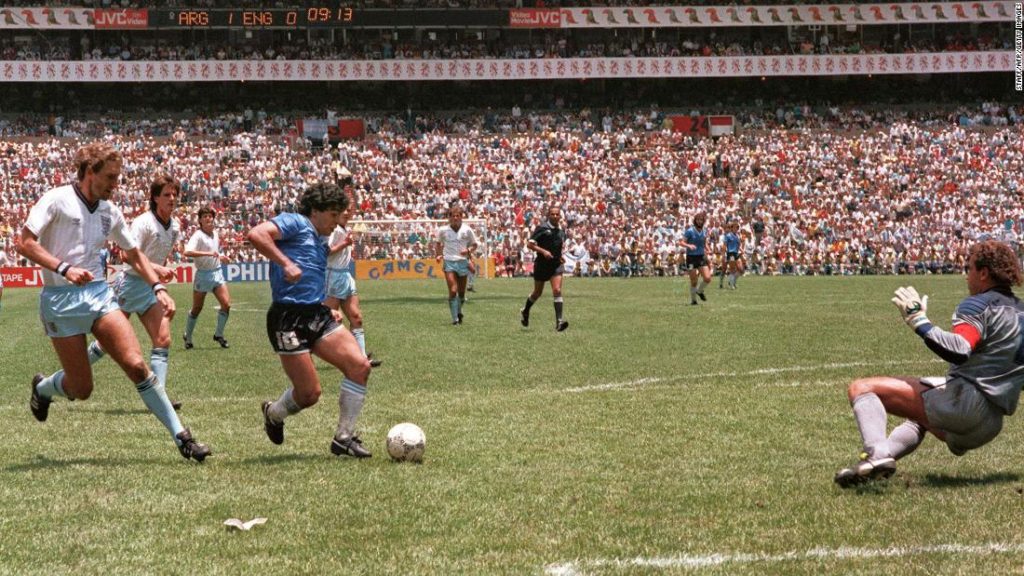Those four words — “the hand of God” — describe one of the most iconic moments in football history, a goal that belongs to one of the most iconic footballers in the game’s history — Diego Armando Maradona, who has died at the age of 60.
On the afternoon of that moment of divine intervention, a sweltering day in Mexico City in 1986, Maradona was at the peak of his powers.
While that first goal against England in the quarterfinals of the 1986 World Cup — a punch of the ball over goalkeeper Peter Shilton, a player who stood 20 centimeters taller than the diminutive Argentine — showcased Maradona’s guile, the one that followed four minutes later displayed in full the majesty of his footballing abilities.
After receiving the ball inside his own half, Maradona weaved this way and that, his short, stocky legs pumping rapidly as he left seven England defenders in his wake, rounded Shilton and slotted the ball into the net.
“Genius! Genius! Genius!” went the legendary commentary of announcer Victor Hugo Morales. “What planet did you come from? I want to cry.”
Maradona was unquestionably a household name before the 1986 World Cup, but after leading Argentina to the title he became a bonafide global superstar.
The highs and lows
Maradona’s stratospheric highs on the pitch were matched by extreme lows off it. His well-documented addiction, substance abuse, illegitimate children and feuds over money all blighted the Argentine at various stages throughout his career.
While he was captivating the world and bringing glory to Argentina in Mexico, Maradona’s personal life was shrouded in controversy.
His mistress Cristiana Sinagra was back in Italy, heavily pregnant with Diego Armando Maradona Sinagra. For years he refused to acknowledge paternity and did not meet his son until 2003.
Kapadia’s film shows occasions when Maradona came into contact with the Camorra — the Neapolitan mafia — with the documentary flashing up photographs of the footballer smiling alongside members of the crime syndicate.
As a Napoli player at the height of his addiction he would party from Sunday to Wednesday, Maradona describing how he would return home and lock himself in the bathroom to hide from his infant daughters.
The God of Naples
Despite football eventually leading him down this dark path, Maradona described the sport as his “salvation.” His talent helped him raise his family out of poverty, leaving Boca Juniors in his native Argentina for a world record transfer fee to Barcelona in 1982.
The five foot, five inch magician spent two injury-ravaged years at the Catalan club, never fully realizing his potential, before signing for Napoli — or, as one newsreader put it: “The poorest city in Italy buys the most expensive player in the world.”
In the city of Naples, football is a religion to its inhabitants. Maradona would go on to become their God.
At his unveiling, 70,000 fans flocked to Napoli’s San Paolo stadium to catch a glimpse of their new signing, scarcely able to believe that the greatest footballer on the planet had chosen to play for their team.
During his seven years at the club, he would guide Napoli, almost single-handedly, to its first ever Serie A title in 1987. He followed it up by winning a second three years later, while also leading the team to Italian Cup and UEFA Cup glory.
Murals of Maradona’s face are painted far and wide across the city, some depicting “The Golden Boy” with a shimmering halo. Though he hails from another continent entirely, Maradona became Naples’ adopted son.
Following a failed drug test in 1991 and a 15-month ban from football, as well as another failed drug test at the 1994 World Cup, his career on the pitch fizzled out. While he had stints in Spain and back in Argentina, he failed to reclaim that form which dazzled fans and opponents.
Maradona’s subsequent nomadic managerial career has taken him from a chaotic spell in charge of the Argentine national team to the domestic league in the United Arab Emirates.
His time in charge of Mexican club Dorados, which was documented in the behind the scenes Netflix series “Maradona in Mexico,” was surprisingly successful, but ultimately ended with two narrow promotion play-off defeats.
The red carpet has been rolled out wherever Maradona has gone — or a throne, as was the case when he returned to boyhood side in Newell’s Old Boys’ while in charge of current club Gimnasia y Esgrima de La Plata.
Many have played the game, but none have left a lasting mark quite like El Diego.
You may also like
-
Super League: UEFA forced to drop disciplinary proceedings against remaining clubs
-
Simone Biles says she ‘should have quit way before Tokyo’
-
Kyrie Irving: NBA star the latest to withhold vaccination status
-
Roger Hunt: English football mourns death of Liverpool striker and World Cup winner
-
‘Every single time I lift the bar, I’m just lifting my country up’: Shiva Karout’s quest for powerlifting glory

